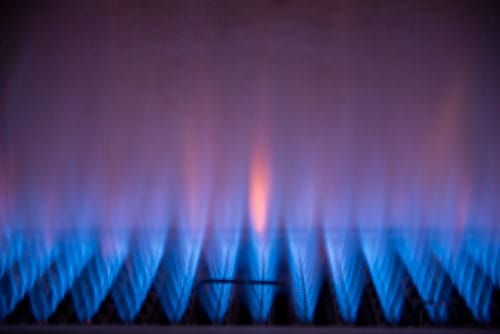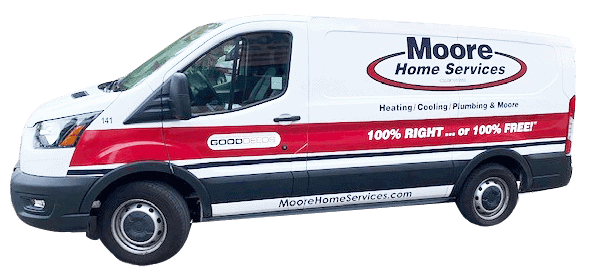What To Do: A Cracked Heat Exchanger In Your Furnace
The heat exchanger on a furnace is like the transmission in your car. Your furnace won’t run without it. And if it needs fixed – you’re looking at a costly repair.
If you have an estimate from a local HVAC company, ask them to show you the cracks first. They are always visible. Don’t let them scare you into buying new equipment. Moore Home Services always offers free second opinions on estimates.
What Causes A Heating Exchanger To Crack?
There is a major implication to a device heating your home too quickly, and it happens in your heat exchanger. Natural gas combustion produces water; however, the flame stays on long enough to help evaporate the condensation. When your furnace short-cycles, the flame goes out quickly — and the condensation stays in the heat exchanger.
Your Furnace is Oversized
If you’ve ever seen rust, you know water and metal don’t mix in the long run. Your heat exchanger will eventually crack through due to overheating.
If your ductwork is too small – or your furnace is too big – the airflow doesn’t stop, and your heating system puts in more effort than needed. The end result is a furnace that is constantly overheating.
Change Your Air Filters
Old, dirty air filters are at the root of many furnace issues. A cracked heat exchanger is no exception.

Lack of airflow can be a contributing factor – this is why you need to change your air filters regularly. It’s especially important if you have a bigger family and/or pets. The general rule of thumb to follow for changing your air filter
- Vacation home or single occupant, no pets/allergies: 6 to 12 months.
- Regular home with no pets: 3 months
- With pets: 2 months
- More than one pet or allergies: 20 to 45 days
A heat exchanger on a furnace is integral in passing heat from one fluid to another without allowing the fluids to mix. Bi-products of this process include soot, water vapor, carbon monoxide and carbon dioxide. If your heat exchanger cracks, you open your duct system to these elements.
How Do I Diagnose A Cracked Heat Exchanger?
Seeing is believing, and luckily, often times the homeowner can visually inspect the heat exchanger and notice the holes. Even the smallest crack is enough to affect combustion. But there are other warning signs. The most typical that leads to a service call is the furnace shutting down.
Where Is My Heat Exchanger Located In My Furnace?
The heat exchanger is a set of coils or tubes typically located above the blower and below the plenum, where the pilot light starts. If you are inspecting your heat exchanger for cracks, check the bends or weld areas first. These are the weak areas most likely to break first.
Cracked Heat Exchanger Diagnostics — Shut-Downs, Sensors & Soot
Your furnace will shut down if the sensor detects flue (combustion gas) product in the supply air. The safety switch trips when the blower interferes with the flame due to the crack.
Flame-outs occur when an incorrect mixture of gas and air combust in a heat exchanger. Uncombusted gas builds up until it reaches a high enough volume to be explosive. When that point is reached, the gas combusts and forces flames and air pressure out of any accessible hole in the heat exchanger, including the cracks.
Looking for furnace maintenance? Maintaining proper fuel to air mixtures is a routine item to check in most annual maintenances.
Moore Home Services often receives no-heat service calls due to homes with cracked heat exchangers, as the furnace shuts down because of its safety mechanism. Our service techs always come equipped with the ability to measure flue product in the supply air with special equipment.
If you walk in your home or furnace area and smell something akin to rotten eggs or sulfur, it could be combustion fumes. Additionally, sometimes the soot will come through your duct system and pass through your heat registers. Either one of these warning signs is cause for alarm.
Cracked Heat Exchanger Solutions
For starters, get a carbon monoxide detector. Make sure they are placed in strategic areas of your home. And please remember — NEVER try to run a furnace when your heat exchanger is cracked!
The unfortunate part of having a cracked heat exchanger is, well, there is usually no positive outcome for the homeowner. A cracked heat exchanger can not be repaired – either the part or entire unit must be replaced.
Getting A Heat Exchanger Replacement
Getting a heat exchanger replacement requires your entire furnace being disassembled by a Moore Home Services Professional. You may be lucky if your furnace was recently purchased, and your parts are under warranty. Without the coverage, you’re looking at a four-figure cost to fix the issue.
Is A Simple Heat Exchanger Replacement Worth It?
Due to the nature of what causes a cracked heat exchanger, which can include an oversized furnace, or a unit close to its life expectancy, the cost of a replacement could eclipse the that of a new system. The professional recommendation for a cracked heat exchanger is often a full system replacement. Why?
When you add up the energy savings of a properly-sized furnace with utility and factory rebates, tax credits, and other energy savings perks of installing a new, energy-efficient unit, you’ll notice why a full replacement makes sense.
Likewise, installing a new heat exchanger in an already-oversized furnace only delays the inevitable, and is not cost-effective
At a certain age, replacing a heat exchanger is simply not worth it. You can talk to Moore about this.
Our NATE-certified technicians can provide a quick diagnostic and recommendation based on your home’s needs. And we always offer FREE estimates and second opinions.
And of course, we do the legwork on any and all financing you need to replace your furnace due to a heating exchanger problem.

